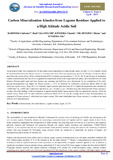Please use this identifier to cite or link to this item:
http://ir-library.mmust.ac.ke:8080/xmlui/handle/123456789/2503Full metadata record
| DC Field | Value | Language |
|---|---|---|
| dc.contributor.author | Salvator, KABONEKA | - |
| dc.contributor.author | ONG’OR, Basil T.Iro | - |
| dc.contributor.author | Chantal, KWIZERA | - |
| dc.contributor.author | Menus, NKURUNZIZA | - |
| dc.contributor.author | Elie, KWIZERA | - |
| dc.date.accessioned | 2023-12-15T06:53:30Z | - |
| dc.date.available | 2023-12-15T06:53:30Z | - |
| dc.date.issued | 2019-04-04 | - |
| dc.identifier.uri | https://doi.org/10.31695/IJASRE.2019.33119 | - |
| dc.identifier.uri | https://ijasre.net/index.php/ijasre/article/view/159/194 | - |
| dc.identifier.uri | http://ir-library.mmust.ac.ke:8080/xmlui/handle/123456789/2503 | - |
| dc.description.abstract | An incubation study was conducted for 56 days under room temperature in a high altitude acidic soil (pH = 4.2) to evaluate carbon (C) mineralization from pea (Pisum sativum L.) residues and leaves from two agroforestry species (Calliandra calothyrsus Meisnand Gliricidia sepium (Jacq.) Walp. Carbon dioxide (CO2) evolution was measured at 7, 14, 21, 28, 42 and 56 days of incubation. Carbon mineralization was best fit to a sequential decomposition model with a rapid and slow phase, each described by first-order kinetics. Percent rapid, rapid and slow fraction rate constants and half-lives were determined. At the completion of the study, percent decomposition was higher for Pisum sativum L. (77.3 %) followed by Calliandra calothyrsus Meisn(60.8 %) and Gliricidia sepium (Jacq.) Walp(56.7 %). Similarly, higher percent rapid fractions (78 %), higher decomposition rate constants (kr = 0.053 day-1; ks = 0.012 day-1) and lower half-lives [t0.5(r) = 13 days; t0.5(s) = 58 days] were also observed with Pisum sativum L.residues. From the findings of this investigation, it appears that the higher lignin content of the two agroforestry species,Gliricidia sepium (Jacq.) Walp(6.33 %) and Calliandra calothyrsus Meisn(4.16 %) was the limiting factor of their decomposability, as compared toPisum sativum L. which had zero lignin content.This study highlighted pea (Pisum sativum L.) residue as the most effective in C mineralization | en_US |
| dc.language.iso | en | en_US |
| dc.publisher | International Journal of Advances in Scientific Research and Engineering (ijasre) | en_US |
| dc.subject | Carbon, Mineralization, Kinetics, Legume, Residues, Applied, High, Altitude, Acidic, Soil | en_US |
| dc.title | Carbon Mineralization Kinetics from Legume Residues Applied to a High Altitude Acidic Soil | en_US |
| dc.type | Article | en_US |
| Appears in Collections: | Journal Articles | |
Files in This Item:
| File | Description | Size | Format | |
|---|---|---|---|---|
| Carbon Mineralization Kinetics fromLegume Residues Applied to aHigh Altitude Acidic Soil.pdf | 677.34 kB | Adobe PDF |  View/Open |
Items in DSpace are protected by copyright, with all rights reserved, unless otherwise indicated.
